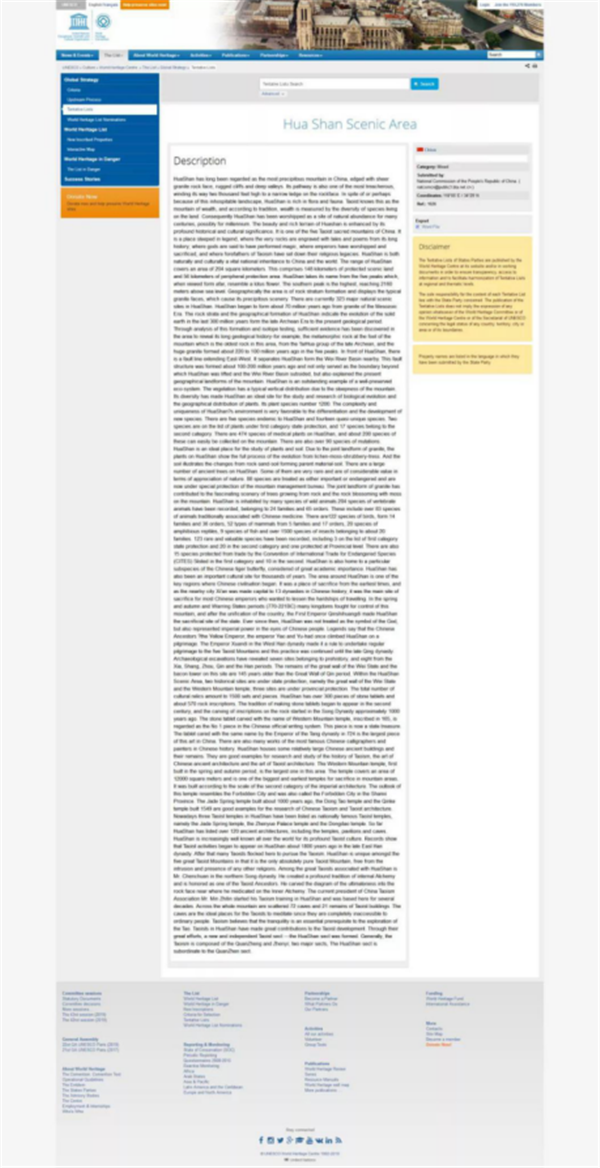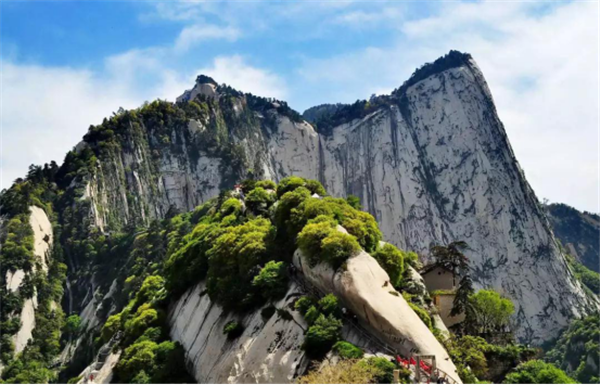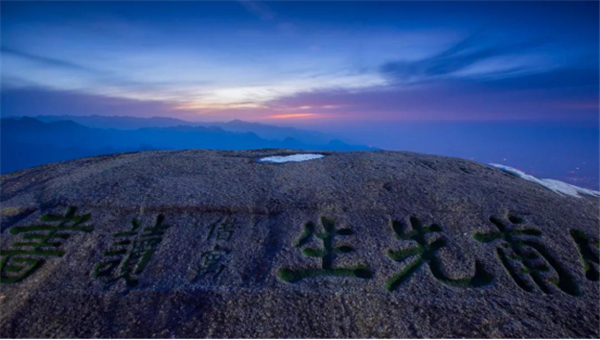國際說華山︱聯(lián)合國科教文組織--華山景區(qū)地質介紹
2019-05-15 17:13:33
來源:華山景區(qū)
分享到





近期,聯(lián)合國教科文組織官網發(fā)布了一篇華山簡介,我們進行了翻譯和整理,小編這就po出來,讓大家看看聯(lián)合國眼中的華山風光。
HuaShan Scenic Area Description
By UNESCO(聯(lián)合國科教文組織)
HuaShan has long been regarded as the most precipitous mountain in China, edged with sheer granite rock face, rugged cliffs and deep valleys. Its pathway is also one of the most treacherous, winding its way two thousand feet high to a narrow ledge on the rockface. In spite of or perhaps because of this inhospitable landscape, HuaShan is rich in flora and fauna. Taoist knows this as the mountain of wealth, and according to tradition, wealth is measured by the diversity of species living on the land. Consequently HuaShan has been worshipped as a site of natural abundance for many centuries, possibly for millennium. The beauty and rich terrain of Huashan is enhanced by its profound historical and cultural significance. It is one of the five Taoist sacred mountains of China. It is a place steeped in legend, where the very rocks are engraved with tales and poems from its long history; where gods are said to have performed magic, where emperors have worshipped and sacrificed; and where forefathers of Taoism have set down their religious legacies. HuaShan is both naturally and culturally a vital national inheritance to China and the world. The range of HuaShan covers an area of 204 square kilometers. This comprises 148 kilometers of protected scenic land and 56 kilometers of peripheral protection area. HuaShan takes its name from the five peaks which, when viewed form afar, resemble a lotus flower. The southern peak is the highest, reaching 2160 meters above sea level. Geographically the area is of rock stratum formation and displays the typical granite faces, which cause its precipitous scenery. There are currently 323 major natural scenic sites in HuaShan. HuaShan began to form about 70 million years ago from granite of the Mesozoic Era. The rock strata and the geographical formation of HuaShan indicate the evolution of the solid earth in the last 300 million years form the late Archean Era to the present geological period. Through analysis of this formation and isotope testing, sufficient evidence has been discovered in the area to reveal its long geological history-for example, the metamorphic rock at the foot of the mountain which is the oldest rock in this area, from the TaiHua group of the late Archean, and the huge granite formed about 220 to 100 million years ago in the five peaks. In front of HuaShan, there is a fault line extending East-West. It separates HuaShan form the Wei River Basin nearby. This fault structure was formed about 100-200 million years ago and not only served as the boundary beyond which HuaShan was lifted and the Wei River Basin subsided, but also explained the present geographical landforms of the mountain. HuaShan is an outstanding example of a well-preserved eco-system. The vegetation has a typical vertical distribution due to the steepness of the mountain. Its diversity has made HuaShan an ideal site for the study and research of biological evolution and the geographical distribution of plants. Its plant species number 1200. The complexity and uniqueness of HuaShan?s environment is very favorable to the differentiation and the development of new species. There are five species endemic to HuaShan and fourteen quasi-unique species. Two species are on the list of plants under first category state protection, and 17 species belong to the second category. There are 474 species of medical plants on HuaShan, and about 200 species of these can easily be collected on the mountain. There are also over 90 species of mutations. HuaShan is an ideal place for the study of plants and soil. Due to the joint landform of granite, the plants on HuaShan show the full process of the evolution from lichen-moss-shrubbery-tress. And the soil illustrates the changes from rock-sand-soil forming parent material-soil. There are a large number of ancient trees on HuaShan. Some of them are very rare and are of considerable value in terms of appreciation of nature. 88 species are treated as either important or endangered and are now under special protection of the mountain management bureau. The joint landform of granite has contributed to the fascinating scenery of trees growing from rock and the rock blossoming with moss on the mountain. HuaShan is inhabited by many species of wild animals.204 species of vertebrate animals have been recorded, belonging to 24 families and 65 orders. These include over 83 species of animals traditionally associated with Chinese medicine. There are122 species of birds, form 14 families and 36 orders, 52 types of mammals from 5 families and 17 orders, 20 species of amphibious reptiles, 9 species of fish and over 1500 species of insects belonging to about 20 families. 123 rare and valuable species have been recorded, including 3 on the list of first category state protection and 20 in the second category and one protected at Provincial level. There are also 15 species protected from trade by the Convention of International Trade for Endangered Species (CITES) 5listed in the first category and 10 in the second. HuaShan is also home to a particular subspecies of the Chinese tiger butterfly, considered of great academic importance. HuaShan has also been an important cultural site for thousands of years. The area around HuaShan is one of the key regions where Chinese civilisation began. It was a place of sacrifice from the earliest times, and as the nearby city Xi'an was made capital to 13 dynasties in Chinese history, it was the main site of sacrifice for most Chinese emperors who wanted to lessen the hardships of travelling. In the spring and autumn and Warring States periods (770-221BC) many kingdoms fought for control of this mountain, and after the unification of the country, the First Emperor Qinshihuangdi made HuaShan the sacrificial site of the state. Ever since then, HuaShan was not treated as the symbol of the God, but also represented imperial power in the eyes of Chinese people. Legends say that the Chinese Ancestors ?the Yellow Emperor, the emperor Yao and Yu-had once climbed HuaShan on a pilgrimage. The Emperor Xuandi in the West Han dynasty made it a rule to undertake regular pilgrimage to the five Taoist Mountains and this practice was continued until the late Qing dynasty. Archaeological excavations have revealed seven sites belonging to prehistory, and eight from the Xia, Shang, Zhou, Qin and the Han periods. The remains of the great wall of the Wei State and the bacon tower on this site are 145 years older than the Great Wall of Qin period. Within the HuaShan Scenic Area, two historical sites are under state protection, namely the great wall of the Wei State and the Western Mountain temple; three sites are under provincial protection. The total number of cultural relics amount to 1500 sets and pieces. HuaShan has over 300 pieces of stone tablets and about 570 rock inscriptions. The tradition of making stone tablets began to appear in the second century, and the carving of inscriptions on the rock started in the Song Dynasty approximately 1000 years ago. The stone tablet carved with the name of Western Mountain temple, inscribed in 165, is regarded as the No 1 piece in the Chinese official writing system. This piece is now a state treasure. The tablet cared with the same name by the Emperor of the Tang dynasty in 724 is the largest piece of this art in China. There are also many works of the most famous Chinese calligraphers and painters in Chinese history. HuaShan houses some relatively large Chinese ancient buildings and their remains. They are good examples for research and study of the history of Taoism, the art of Chinese ancient architecture and the art of Taoist architecture. The Western Mountain temple, first built in the spring and autumn period, is the largest one in this area. The temple covers an area of 12000 square meters and is one of the biggest and earliest temples for sacrifice in mountain areas. It was built according to the scale of the second category of the imperial architecture. The outlook of this temple resembles the Forbidden City and was also called the Forbidden City in the Shanxi Province. The Jade Spring temple built about 1000 years ago, the Dong Tao temple and the Qinke temple built 1549 are good examples for the research of Chinese Taoism and Taoist architecture. Nowadays three Taoist temples in HuaShan have been listed as nationally famous Taoist temples, namely the Jade Spring temple, the Zhenyue Palace temple and the Dongdao temple. So far HuaShan has listed over 120 ancient architectures, including the temples, pavilions and caves. HuaShan is increasingly well known all over the world for its profound Taoist culture. Records show that Taoist activities began to appear on HuaShan about 1800 years ago in the late East Han dynasty. After that many Taoists flocked here to pursue the Taoism. HuaShan is unique amongst the five great Taoist Mountains in that it is the only absolutely pure Taoist Mountain, free from the intrusion and presence of any other religions. Among the great Taoists associated with HuaShan is Mr. Chenchuan in the northern Song dynasty. He created a profound tradition of internal Alchemy and is honored as one of the Taoist Ancestors. He carved the diagram of the ultimateness into the rock face near where he medicated on the Inner Alchemy. The current president of China Taoism Association Mr. Min Zhitin started his Taoism training in HuaShan and was based here for several decades. Across the whole mountain are scattered 72 caves and 21 remains of Taoist buildings. The caves are the ideal places for the Taoists to meditate since they are completely inaccessible to ordinary people. Taoism believes that the tranquility is an essential prerequisite to the exploration of the Tao. Taoists in HuaShan have made great contributions to the Taoist development. Through their great efforts, a new and independent Taoist sect ---the HuaShan sect was formed. Generally, the Taoism is composed of the QuanZheng and Zhenyi; two major sects, The HuaShan sect is subordinate to the QuanZhen sect.
英文版

聯(lián)合國教科文組織官網華山篇網頁截圖
聯(lián)合國科教文組織--華山景區(qū)地質介紹
華山自古以來就被認為是中國最險峻的山峰,以峻峭的山崖和深谷而聞名。它的道路也以危險著稱,曲折直上2千多米高的山峰。也許由于這種不利的自然條件,華山才會擁有豐富的動植物資源。道士們知道這就是財富之山,根據(jù)傳統(tǒng),財富是以生活在這片土地上的生物多樣性來衡量的。因此華山數(shù)千年來一直被認為是自然界的寶庫而備受崇拜。

華山的美麗和豐富地貌也因它文化和歷史的厚重而更加有名。它是中國著名的五岳之一,它是一個沉浸于傳奇中的地方。它的巖石上都鐫刻上了漫長歷史的傳說和詩歌,那里到處充滿神的奇跡,皇帝的祭祀以及道教祖師開創(chuàng)宗教的傳奇。
華山在文化和自然方面都是中國和世界的一個重要遺產,華山方圓204平方公里,包括148平方公里的風景區(qū)和56公里的外圍保護區(qū)。華山得名于從遠處看猶如蓮花盛開的五峰,南峰最高,海拔2154.9米。地質上來說,華山呈典型的花崗巖發(fā)育,因而看起來很險峻,目前華山有323個主要自然景點。華山是由7千萬年前的中世代花崗巖開始形成的,華山的巖石層和地理組成反映了3億年來從太古代到新生代地球的演化,通過對這種結構和同位素的分析,發(fā)現(xiàn)了足夠的證據(jù)去揭示它漫長的地質歷史。例如,山腳下的巖石是這個地區(qū)最古老的巖石,五座主峰的花崗巖形成于1千萬年到2千萬年以前。在華山前面,有一個由東向西的斷層,它把華山和附近的渭河平原分開,這個斷層形成于1千萬年到2千200萬年以前。不但是華山抬升和渭河平原沉降的分界線,而且可以解釋現(xiàn)在華山的地貌結構。

華山是一個生態(tài)系統(tǒng)受到良好保護的典型例證,由于山勢陡峭,植被呈典型垂直分布,它的多樣性使華山成為研究和學習生物演化和植物地理分布的理想場所。它的植物種類超過1,200余種,華山環(huán)境的復雜性和獨特性特別有益于新物種的變異和發(fā)展,有5個物種是當?shù)靥赜械模?個物種屬于國家一類保護范圍,17個物種屬國家二級保護范圍。華山上有474種藥用植物,200多種可在華山很容易采集,也有90個植物變種。華山是研究植物和土壤的理想場所,由于花崗巖的綜合地形結構,華山上的植物呈現(xiàn)地衣——苔蘚——灌木——樹木的完整演化過程,土壤也是呈石頭——沙子——土壤的變化。華山上有一大批古樹,有的相對珍稀,從自然的角度看很有價值,88個重要瀕危物種列入當?shù)毓芾聿块T的特別保護之中?;◢弾r的共同地形使生長在巖石上的樹木和苔蘚分外美麗。華山上也有很多野生動物,記載有204種脊柱動物,屬于24科和65目,83種動物和中醫(yī)藥有關,有122種鳥類,分屬14科和36目,分屬于5科和17目的52種哺乳動物,24種的兩棲爬行動物,9種魚類和分屬20科的超過1,500種的昆蟲,123種珍稀物種被記錄在案,3種在國家一級保護名錄之內,20種在二級保護名錄之內,一種在省級保護名錄之內,15種列入聯(lián)合國瀕危物種大會禁止貿易的范圍之內。華山也是中華虎蝶的一個特別亞屬品種的家園,被認為有重大的學術重要性。

華山也是一個延續(xù)數(shù)千年的文化場所,華山周圍地區(qū)是中華文明發(fā)源的重要地區(qū),它很早就是一個祭祀場所,附近的城市西安在中國歷史上曾作為13朝古都,許多中國皇帝為了免去旅途勞累,就把華山作為祭神的場所。在春秋戰(zhàn)國,許多諸侯國為了占據(jù)此山而發(fā)生戰(zhàn)爭,國家一統(tǒng)后,秦始皇把華山作為國家祭祀的場所。從此之后,華山在普通中國人心里不但是神靈的象征,而且兼有皇權的威嚴。傳說中中國人的先祖黃帝、堯和舜都曾拜祭華山,西漢宣帝把祭祀五岳當成了一項制度,并延續(xù)至晚清,考古發(fā)現(xiàn)華山有7處地方屬于史前文明,8處地方分別屬于夏、商、周、秦和漢代,魏長城遺址和烽火臺比秦長城還早145年。在華山風景區(qū)內,有兩處國家級歷史遺址,分別是魏長城和西岳廟,三處遺址屬省級保護范圍,文化遺存的數(shù)目達1,500余個,華山共有300個石碑和570個石刻,制作石碑的傳統(tǒng)始于公元二世紀,巖石上刻字則始于大約1千年前的宋代。刻有西岳廟名字的一則石碑銘刻于公元165年,被認為是中國官方書寫系統(tǒng)的第一則石碑。這則石碑現(xiàn)在被認為是國家珍寶。建于公元724年唐朝的一通石碑則是中國石碑中最大的一個,這里也有中國歷史上最著名的書法家和畫家,華山有相當多的古代建筑遺存,他們是研究中國道家歷史、中國古代建筑和中國道教建筑的很好例子。

初建于西漢的西岳廟是這個地區(qū)最大的建筑,規(guī)格僅次于皇宮,它的外觀很像北京故宮,因而又被稱為陜西小故宮。玉泉院建于公元1千年前,東道院和青柯院建于公元1549年,都是研究中國道教和道教建筑的很好例子?,F(xiàn)在華山有三座道教宮觀是全國著名道觀,分別是玉泉院、鎮(zhèn)岳宮和東道院。華山目前一共有120個古代建筑,包括寺院、亭子和巖洞。華山也因深厚的道教文化而在世界上越來越有名,記錄表明1,800年前東漢末年華山就有了道教活動,自那以后很多道士來華山研習道教。華山在五岳之中也很獨特,它是一座純道教名山,沒有其他宗教的侵入和存在。和華山有關的最著名的道士當屬北宋的陳摶,他創(chuàng)造了深厚的內在修煉術,被認為是道教的祖師之一,他在修煉地方的石頭上刻畫了無極圖。當前中國道教協(xié)會主席閔智亭就是在華山學習道教,并在此修行數(shù)十年。整個華山有72個洞窟和21個道教建筑遺址,這些洞窟是道士修行的理想場所,因為它們對常人來說是難以到達的,道士們認為寧靜是修煉道教的先決條件。華山道士對道教的發(fā)展做出了重大的貢獻,由于他們的努力,一個新的、獨立的道教分支——華山派形成了,一般來說,道教有全真派和正一派兩大分支,華山派則從屬于全真派。(翻譯自聯(lián)合國教科文組織官網)

科普——聯(lián)合國教科文組織是什么機構?
聯(lián)合國教科文組織為聯(lián)合國教育、科學及文化組織的簡稱,英文縮寫為UNESCO(United Nations Educationnel, Scientific and Cultural Organization)。聯(lián)合國教科文組織是各國政府間討論關于教育、科學和文化問題的國際組織。
返回頂部



